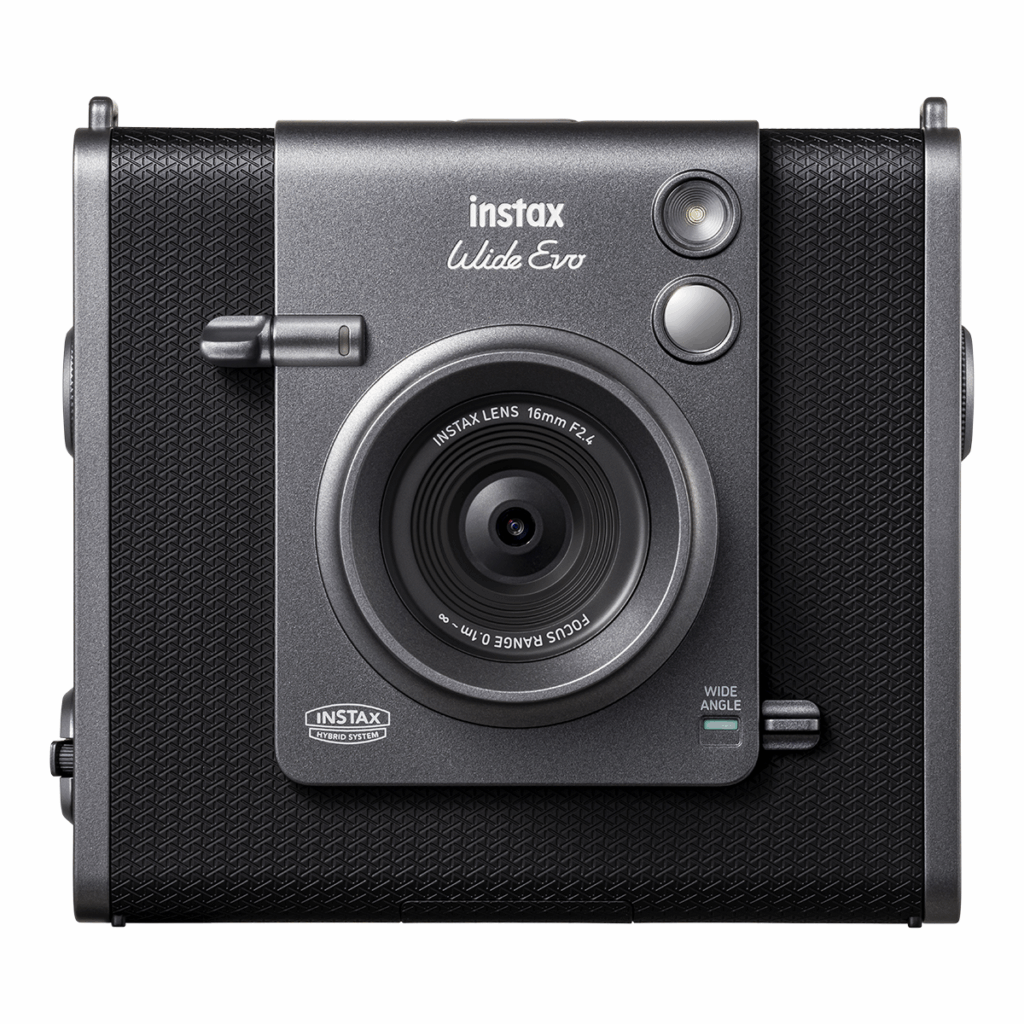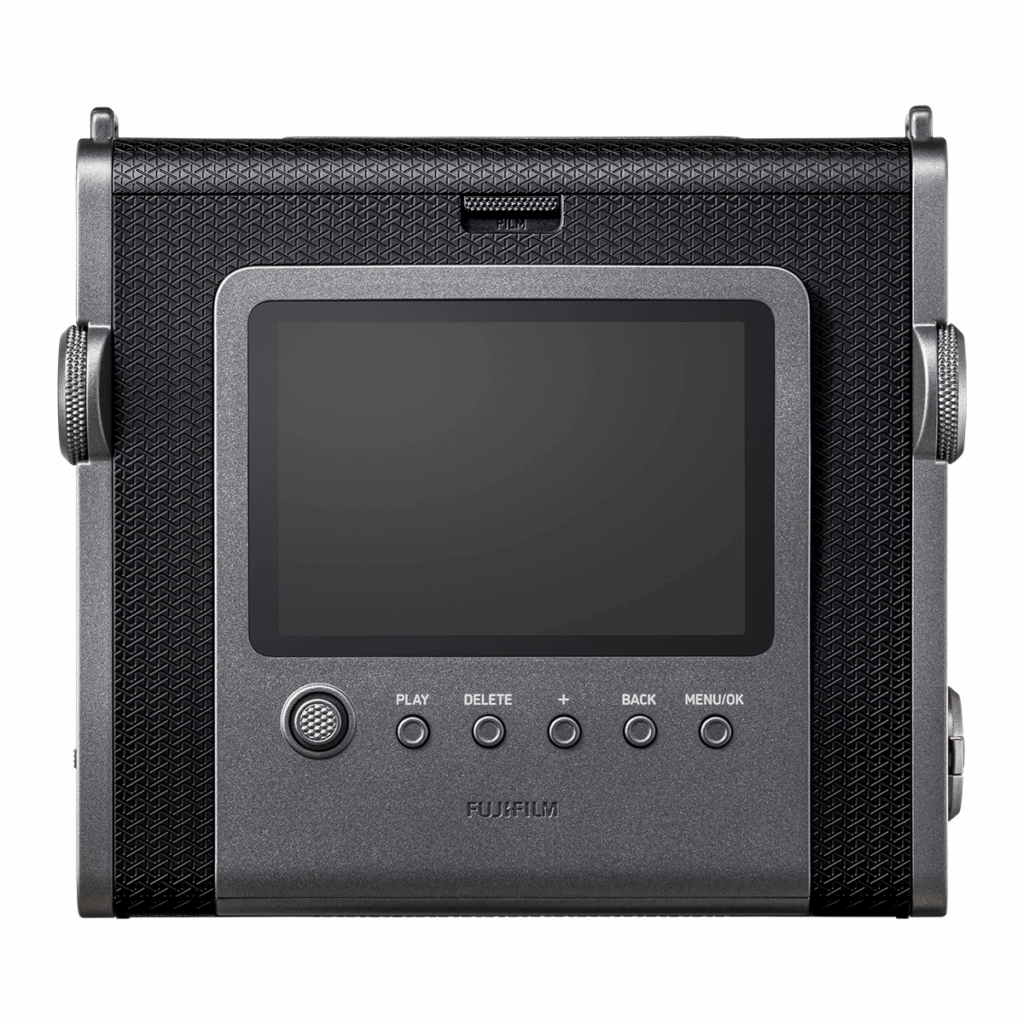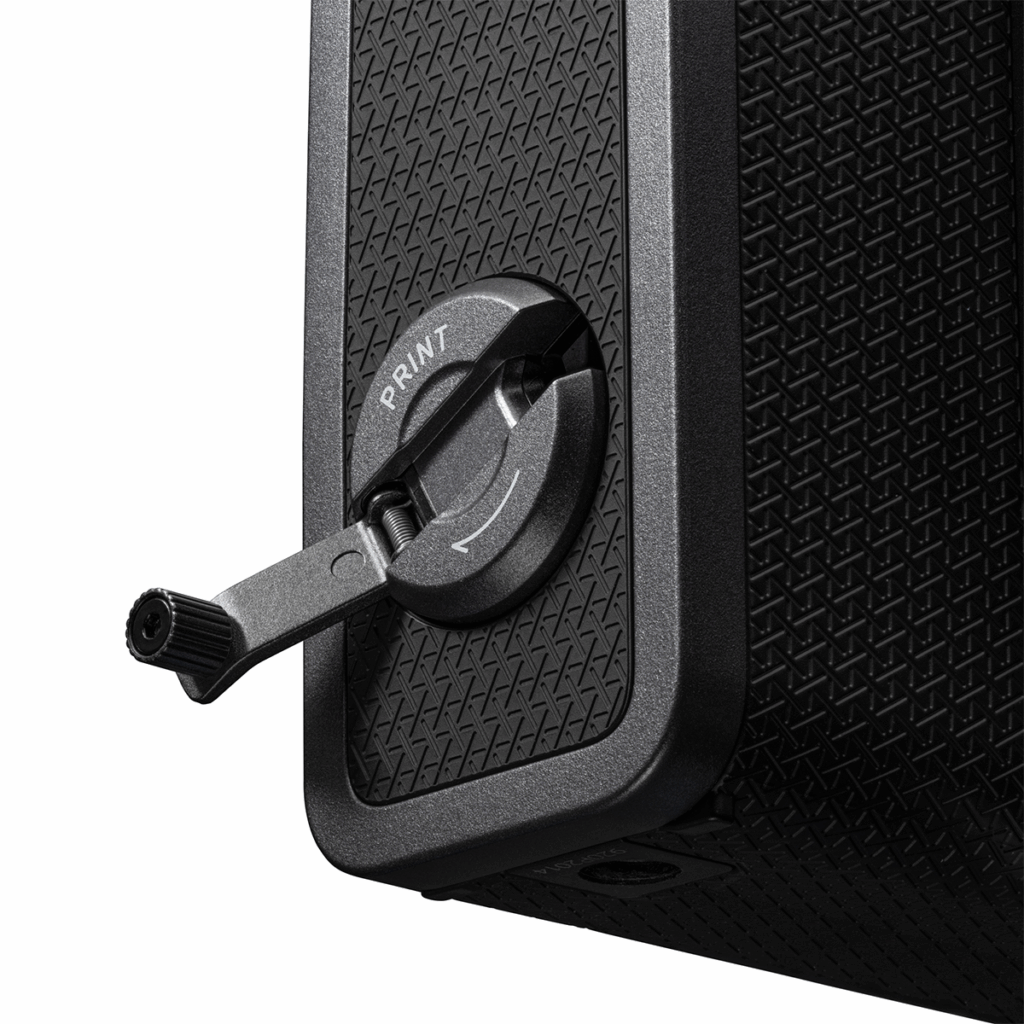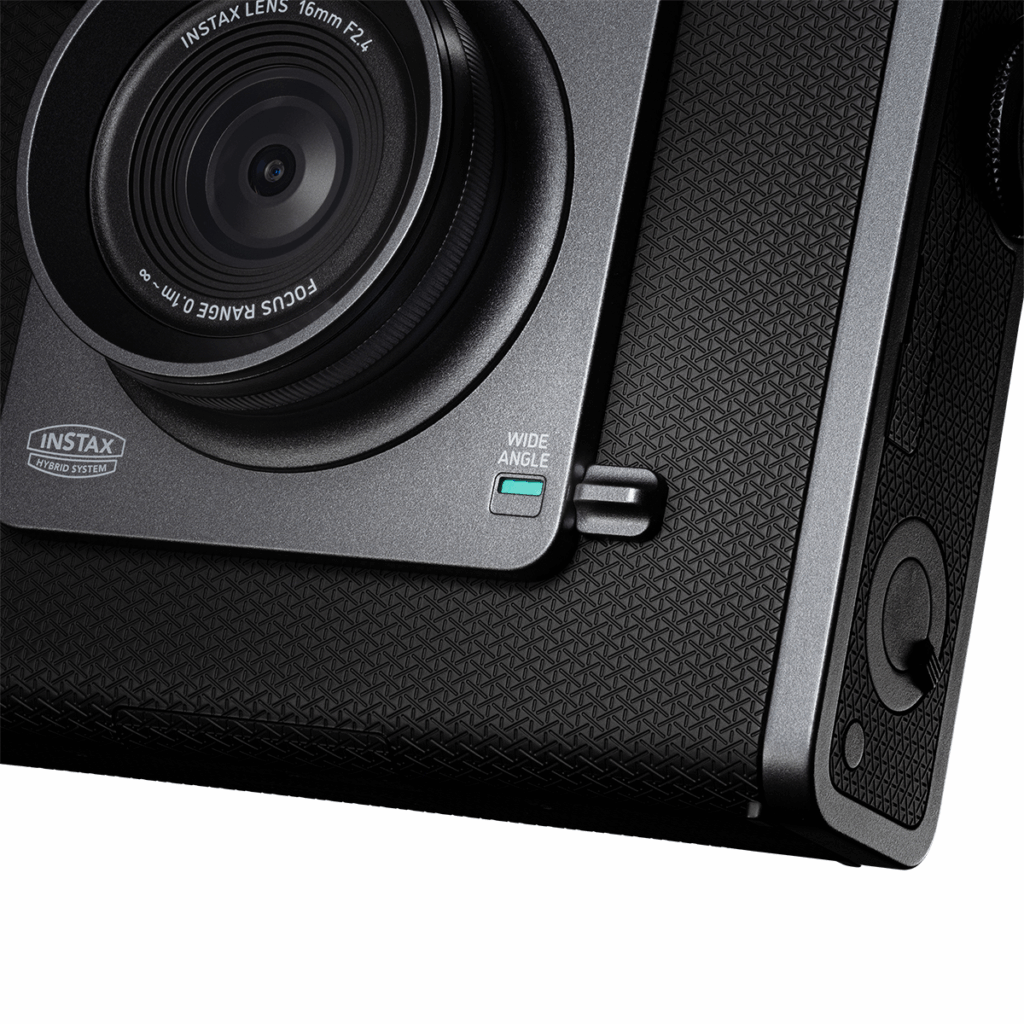The Fujifilm Instax Wide Evo is the brand’s second hybrid instant camera—but it’s the first to use wide-format film. This means you can take instant photos or use it as a smartphone printer.
It blends the retro design of the Instax Mini Evo with the large prints of the Instax Wide 400. The result is a stylish camera that offers both creativity and versatility.
You get access to Fujifilm’s app, a wide range of lenses and film effects, and multiple film options. It’s packed with features, but it comes at a premium price.
Pros
- Hybrid design for both digital and instant photography
- 100 filter and effect combinations
- Wide-angle lens improves landscapes and selfies
- Retro look with a manual hand crank for printing
- Connects to smartphone via Fujifilm app
Considerations
- High price—nearly double the cost of the Mini Evo
- Digitally printed images can appear flat
- No viewfinder; relies on LCD screen
- Rocker switch shutter makes selfies harder to take
Table of Contents
Fujifilm Instax Wide Evo Quick Review
The Fujifilm Instax Wide Evo stands out with its retro design and wide body. If you enjoy hybrid photography—printing photos taken on the camera or from your phone—and prefer wide-format prints, this camera is a strong contender.
It’s more expensive than other Instax models, but it offers a clear upgrade from the Mini Evo released in 2021. You get:
- A 3-inch LCD screen
- 10 lens effects and 10 film effects (100 creative combinations)
- A microSD card slot
- Several new features that enhance usability
The camera’s larger size accommodates more physical controls. These include a dedicated wide-angle button that switches to a standard field of view, allowing for a less cinematic look.

You can also choose from six film styles. One adds black bars to mimic an IMAX-style frame. A dial on the left lets you scroll through lens effects, while a dial on the right changes film effects.
One standout feature is the manual crank. It lets you print photos by turning it, echoing the feel of classic film cameras.
Creativity is where the Instax Wide Evo shines. It earns top marks for its editing options and hands-on controls.
However, image quality is more comparable to that of smartphone prints than to traditional analog instant film. The digital-first nature of the camera means it won’t match the richness or unpredictability of true analog prints.
This camera won’t replace your digital camera. And if you love the charm of fully analog instant film, it may not be for you. But if you want to experiment with wide-format prints and creative effects, the Instax Wide Evo is a fun and flexible tool to add to your kit.
Fujifilm Instax Wide Evo: Price and Availability
The Fujifilm Instax Wide Evo launched on January 21, 2025. It retails for:
- $349.95 in the US
- £319.99 in the UK
- AU$ 599 in Australia
This makes it one of the most expensive instant cameras in its category. For comparison:
- The Instax Wide 400, which also uses wide-format film, costs $149.99 / £129.99 / AU$ 229.99.
- The Instax Mini Evo, another hybrid model, is priced at $199.99 / £174.99 / AU$ 299.99.
While the Wide Evo offers more advanced features and a premium build, it comes at a steep price. Whether it’s worth the extra cost depends on how much you value its larger format and creative controls.
Optional accessories are also available. A leather case costs $49.95 (US) or £37.99 (UK). While not essential, it helps protect the LCD screen—important if you want to keep the display scratch-free and usable.

Fujifilm Instax Wide Evo: Key Specs
- Film Type: Fujifilm Instax Wide
- Print Size: 62mm x 99mm
- Lens: 16mm (35mm equivalent)
- Aperture: f/2.4
- Shutter Speed: 1/4 to 1/8,000 sec (automatic)
- Power: Built-in rechargeable lithium-ion battery
- Charging Time: 2–3 hours
- Dimensions: 138.7 x 125 x 62.8 mm (excluding protrusions)
- Weight: 490g
Fujifilm Instax Wide Evo: Design
The Fujifilm Instax Wide Evo is a hybrid instant camera that prints photos directly or from a microSD card. It features a variety of dials and switches, making it easy to apply different lens and film effects. A built-in mirror and selfie switch also make it simple to take self-portraits.
When rumors first surfaced, many called it the best-looking Instax camera ever. Now that it’s here, it’s clear the design lives up to the hype.

Despite its wide format, the camera has a relatively slim profile. It’s larger than most instant cameras, but the retro styling—black textured body with silver accents—gives it a premium, vintage feel.
Compared to the bulky and plasticky Instax Wide 400, the Wide Evo looks much more refined. Its minimalist design is easier on the eyes and more comfortable to carry. Another stylish alternative in this format is the Lomo’Instant Wide Glass, which also earned high praise.
The camera weighs about 490g, making it light enough to carry all day. While it won’t fit in your pocket, it’s still very portable. A leather case is available and highly recommended. It protects the camera from scratches and helps preserve the LCD screen, which is especially important since the camera lacks a viewfinder.

Overall, the Instax Wide Evo combines thoughtful design with practical features. It’s a camera you’ll want to show off—and one that’s built to be used on the go.
Fujifilm Instax Wide Evo: Performance
The Instax Wide Evo makes it easy to get creative. With 10 lens effects and 10 film effects, you can mix and match up to 100 combinations. This gives you plenty of room to experiment with different looks and styles.
Fujifilm designed the camera with customization in mind. If you enjoy adding lens flares, borders, or color filters, this camera is built for you. The controls are intuitive, with dedicated dials for both lens and film effects on either side of the camera.
Even the top button—usually reserved for the shutter—is used to apply film styles. A front-facing button lets you toggle the wide-angle lens off, offering a more standard field of view. You can also twist the lens to adjust the intensity of effects, adding another layer of control.
One of the most enjoyable features is the manual crank for printing photos. It’s a nostalgic touch that adds to the camera’s charm and analog feel.
However, not all controls are perfect. The shutter button is a rocker-style switch located beside the lens. It’s less intuitive than the Mini Evo’s top-mounted button and can feel awkward, especially when taking selfies. It may become easier with use, but it takes some getting used to.
That said, most of the controls—like the dials and crank—are tactile and easy to use. They make switching settings and printing photos feel satisfying and hands-on.
The camera also connects to the Instax Wide app. The app lets you crop images, adjust brightness and contrast, and explore a Discovery Feed to see what others are creating. One important note: only printed images are saved automatically to the app. Photos taken with the camera must be transferred manually from the microSD card.
Every printed photo is saved in the app’s library, along with details about the effects used. This makes it easy to track your creative choices and revisit your favorite combinations.
Fujifilm Instax Wide Evo: Image Quality
The Instax Wide Evo produces digital-first images, which means the prints lack the charm of true analog photography. While the digital photos look fine on screen, the printed versions often appear flat and less dynamic.
This is a common trade-off with hybrid instant cameras. They offer convenience and creative control, but not the rich tones or contrast of analog models like the Instax Mini 99. If you’re drawn to instant photography for its nostalgic feel, this difference may matter.
I was especially curious to compare the Wide Evo’s prints to those from a traditional analog Instax. Since the Evo captures images digitally before printing, it loses some of the unpredictability and warmth that analog film provides.
From personal experience, I’ve found analog prints more satisfying. My first Instax camera, bought in 2014, taught me to be selective with shots due to the cost of film. Later, I tried an Instax printer, but the prints felt less vibrant and more disposable. The Wide Evo’s prints fall somewhere in between.
If print quality is your top priority, I’d recommend sticking with a fully analog Instax. Analog prints tend to have better contrast and are less prone to overexposure, thanks to the way light interacts directly with the film.
That said, the larger, wide-format prints from the Evo do feel more premium. They offer more space for your subject and resemble the classic square prints many people love.
As for the digital images, they don’t compete with modern smartphone cameras. The sensors and processing power in today’s phones are far more advanced. So while you can share Evo photos on social media, you probably won’t use them for much else.

